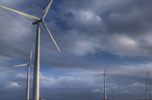

The rapid depletion of conventional energy sources has generated an increased interest in renewable energy.
Countries around the world are implementing subsidies and grants to improve the technologies for generating power from alternative sources. A great deal of effort is being put in to improving the reliability of wind turbines, especially under the influence of high winds that may cause them to fail. One avenue that researchers are exploring is in developing a feedback control system that can provide information in realtime from sensors on turbine blades to prevent damage.
Sensors in the blades
To test this approach, researchers from Purdue University and Sandia Labs have embedded uniaxial and triaxial accelerometers within wind turbine blades as they were constructed. Such sensors can be used to control surfaces of turbine blades and flaps like those on the wings of an aircraft to alter the aerodynamics of the blades for better control.
The information acquired from the sensors in realtime would enable improved response to dynamic wind conditions. This capability makes continuous sensor data a critical asset. Research has shown that using a combination of three sensors along with 'estimator model' software accurately depicts the amount of force being exerted on the blades of the wind turbines. There is a need to identify forces and loads on turbine blades in order to predict their fatigue.
System optimization
Feeding a control system with sensor inputs better enables energy optimisation in the system. The main components of the wind turbine are the blades (made of fibreglass or wood strengthened with carbon fibre), a generator, and a gear box.
Varying wind speeds make it a challenge to operate the turbine and generator for optimum energy capture. This requires decreasing the force on the components during high winds and increasing the load during low winds. The issue of reliability becomes as important as efficiency, since the height of the towers supporting the turbines makes repairs expensive.
The sensors detect two types of acceleration – dynamic acceleration resulting from gusting winds and static acceleration owing to gravity and constant background winds. It is imperative that both types be measured correctly to best quantify the forces exerted on the blades.
Advances in blade design
The sensor data also enables designing more resilient blades since the accelerometers can measure acceleration in different directions. This helps in determining the extent and characteristics of bending and twisting of the blades along with the minor vibrations at the blade’s tip that provides an indication for fatigue or failure.
Sensor inputs in a smart system can be used to control the turbine speed and help by directly modifying the blade pitch and provide feedback to the generator for further corrective measures. The research is likely to represent significant progress in the control of wind turbines, although a lot more work is expected to be done on the system.
Further research will focus on the application of this system to highly advanced turbine blades that are more curved than conventional blades. As this is a more complicated shape to work with, the application of the sensor feedback techniques has proved more challenging. The main aim for the sensor system is to monitor forces on the blades to directly predict oncoming failure and at the same time improve the reliability of the turbine.
For more information contact Patrick Cairns, Frost & Sullivan, +27 (0)18 468 2315, [email protected], www.frost.com

© Technews Publishing (Pty) Ltd | All Rights Reserved